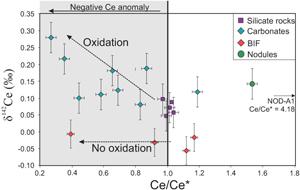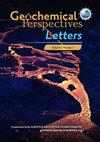作为氧化反应示踪剂的稳定铈同位素
IF 3.7
1区 地球科学
Q1 GEOCHEMISTRY & GEOPHYSICS
引用次数: 0
摘要
过去海洋中的氧化还原条件引起了人们的极大兴趣,许多代用指标被用来探测不同时期的氧化还原变化。例如,Ce 的氧化还原行为导致负或正的元素 Ce 异常,已被广泛使用。最近,质量依赖性铈同位素变化被认为是研究自然环境中铈氧化的有力工具。在这项研究中,我们首次证明了铈同位素在氧化反应过程中会发生分馏,从而证实了铈同位素在研究氧化还原反应方面的实用性。这一结果表明,相对于大陆地壳,海水中的Ce同位素组成应向重值方向分馏。测量到的天然岩石样本(碳酸盐岩、带状铁地层和锰结核)的Ce同位素组成各不相同,从-0.055 ± 0.045 ‰到+0.280 ± 0.045 ‰不等。碳酸盐岩中的Ce元素异常与Ce同位素组成之间的关系表明,与质量相关的Ce同位素可用于区分氧化反应产生的元素异常与其他过程产生的元素异常。质量依赖性Ce同位素分析与La-Ce年代学相结合,是研究过去海洋氧化还原反应的有力工具。本文章由计算机程序翻译,如有差异,请以英文原文为准。

Stable cerium isotopes as a tracer of oxidation reactions
Redox conditions in past oceans have attracted significant interest and many proxies have been used to probe redox changes through time. For example, the redox dependent behaviour of Ce, resulting in negative or positive elemental Ce anomalies, has been widely used. More recently, mass dependent Ce isotopic variations have been proposed as a powerful tool to study Ce oxidation in natural environments. In this study, we demonstrate, for the first time, that Ce isotopes are fractionated during oxidation reaction, confirming the utility of Ce isotopes to study redox reactions. This result suggests that seawater Ce isotopic composition should be fractionated toward heavy values relative to the continental crust. Measured natural rock samples (carbonates, banded iron formations and Mn nodules) have variable Ce isotopic compositions, ranging from −0.055 ± 0.045 ‰ to +0.280 ± 0.045 ‰. The relation between Ce elemental anomalies and Ce isotopic composition in carbonate rocks suggest that mass dependent Ce isotopes can be used to distinguish elemental anomalies produced by oxidation reactions from those produced by other processes. Coupled with La-Ce chronology, mass dependent Ce isotope analysis is a very powerful tool to study redox reactions in past oceans.
求助全文
通过发布文献求助,成功后即可免费获取论文全文。
去求助
来源期刊

Geochemical Perspectives Letters
Earth and Planetary Sciences-Geochemistry and Petrology
CiteScore
7.00
自引率
2.00%
发文量
42
审稿时长
15 weeks
期刊介绍:
Geochemical Perspectives Letters is an open access, internationally peer-reviewed journal of the European Association of Geochemistry (EAG) that publishes short, highest-quality articles spanning geochemical sciences. The journal aims at rapid publication of the most novel research in geochemistry with a focus on outstanding quality, international importance, originality, and stimulating new developments across the vast array of geochemical disciplines.
 求助内容:
求助内容: 应助结果提醒方式:
应助结果提醒方式:


